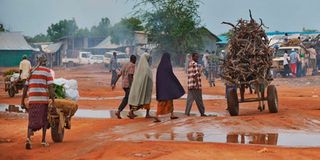Address the concerns of Dadaab refugees

This file photo taken on April 28, 2015 shows Somali refugees at a market at the IFO main camp of the sprawling Dadaab refugee camp in Kenya.
Refugees are ordinary human beings living in foreign countries. They are found all over the world. They are treated well in some countries. But refugees in Dadaab camps, in Garissa County, live in the worst conditions.
They live in open-air prisons called camps for over 30 years. They are technically held incommunicado and can’t even reach Garissa Town for a medical, education, business or ordinary visit.
The conditions are pathetic and dehumanising, what with the endemic confinement. We can’t access human rights organisations and media outlets. The camps are also banditry-prone with many other pressing challenges and issues.
Most refugees in the world, even in other African countries, enjoy the privileges of free movement and integration. However, refugees living in these sprawling encampments in Dadaab camps seem to be the world’s most forgotten and voiceless; nobody seems to know we exist, let alone address our plight.
The hosts—including the public and politicians and other leaders—don’t seem to know our plight and predicament.
Every five years, Kenyans go to the polls to elect their leaders while we are ignored and remain voiceless and forgotten. The media had technically refused to highlight and update our challenges to the world. We have languished in confinement in these camps since the 1990s.
The UNHCR does its best for us, and even funds vital local projects for the host communities for refugees’ sake. Its advancements of refugees’ rights is incapacitated by the bureaucracies of the national government.
The Garissa County government only comes to the camps to collect taxes from our business stalls without offering a single service to us. The government had issued us with alien cards, which are useless since we can’t use them to venture outside.
There is also a deafening and devastating silence by the media—a blackout of sorts. The media had refused to be our voice on the basis of the codes of conduct and principles of professionalism. Kenyan civil rights institutions had failed us tragically due to a number of factors—including the remoteness of our camps and marginalisation. We even wrote to MCK and the KHRC to report our situation in vain.
Every year, World Refugee Day is commemorated in our camps with zero media coverage —not the print, radio, television or online. We don’t know when we shall have a voice through the media so that our problems can be resolutely addressed.
We now appeal for a new beginning while also burying the hatchet. If you study and scrutinise global refugee trends, diverse conditions and treatments, you would, sadly, agree that these are the world’s worst refugee camps in terms of negligence, confinement and duration of a tragic tale of two generations.
Hussein Ahmed Ali, Garissa



